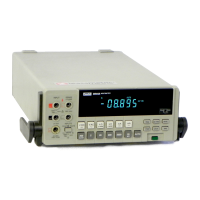Measurement
Tutorial
RESISTANCE
MEASUREMENT
OHMS
CURRENT SOURCE
\
I
VOLTAGE
SENSE
I
\
J
HI
INPUT
LO
INPUT
-
-
UNKNOWN
Figure
4-3.
2-Wire
Ohms
~easurdment
Table
4-1.
Ohms
Test Current
1.
Select tl+e 2-wire ohms function, the 2
kQ
range
-
the medium reading rate.
RANGE
TEST
FULL
SCALE
CURRENT VOLTAGE
2. Connect the test leads to the capacitor (wit1
INPUT HI lead to the
+
lead and the INPUT
LO
2004
1
mA 0.2V
to the
-
lead). The
8840A
will try to charge it t
2
kSZ
1
mA
2.0V open-ciicuit voltage of the
2
kS2
range (about
20
kQ
100
CIA
2.0V
3.
Disconnect the
+
test lead.
200
k!2
10
PA
2.0V
4.
To test for leakage, select the
VDC
function an
2000
k!2
5
clA
1o.ov
20V range (leave the 8840A in the medium re.
20
M4
500
nA
1O.OV rate), add measure the voltage that was stored
o
capacitor during step 2.
4-10.
TESTING DIODES
a. .If the capacitor is good, the voltage acros
The 2-wire ohms function
can
also
be
used to test diodes.
caphcitor will be about 6V, and will
be
re13
1.
Select the 2-wire ohms function and the 2
k&
range.
staqle.
2.
Measure the resistance of the diode. If the diode is
b. If the capacitor is leaky, the voltage acio2
good, when forward-biased it will measure about
0.6
capacitor will be much less than
6V,
an1
kS2
to 0.7
kS2
for silicon (0.25
kQ
to 03
kS2
for
voltage will
be
decreasing. The rate of cl
germanium),
and
when reverse-biased it will cause the
depends on how leaky the capacitor is.
8840A
to indicate overrange. (The forward-biased
reading depends upon the range used.)
c.
Wi4h some electrolytic capacitors, the re
will increase. This usually indicates the
cap
The
2
kS2
range is
used
because its
I
mA
test current
is defective.
provides a typical operating point, and its 2V full-scale
voltage is sufficient to turn on most diodes (even two
5.
To test the capacitor's dielectric absorption,
t:
diodes in series).
short the capacitor's leads together and then
mt
the voltage across the capacitor.
4-1
1.
TESTING ELECTROLYTIC CAPACITORS
The 2-wire ohms function can also give a rough test of an
a.
If
tihe dielectric is good (i-e., has low die1
electrolytic capacitor's leakage and dielectric absorption.
absorption), the
voltage across the capacito
This test works well for capacitors 0.5
pF
and larger.
be nearly zero volts.
-
-
and
the
ead
the
IV.
the
Ling
the
the
rely
the
the
nge
iing
itor
efly
sure
3ric
will
Artisan Technology Group - Quality Instrumentation ... Guaranteed | (888) 88-SOURCE | www.artisantg.com

